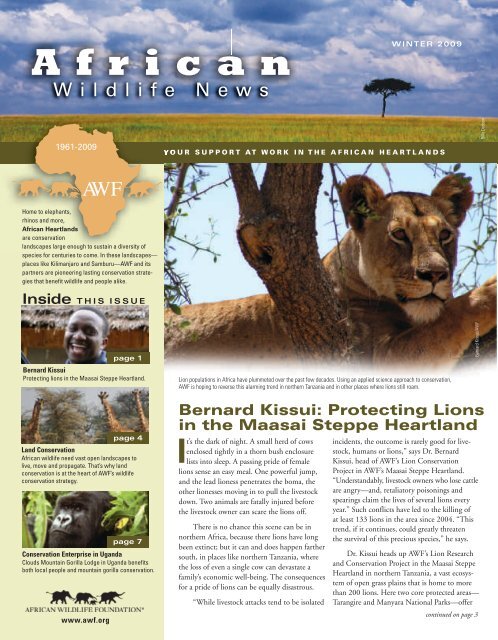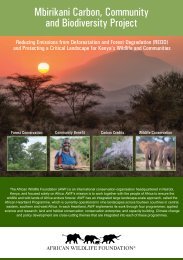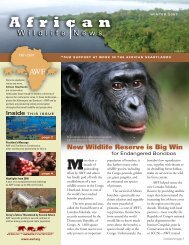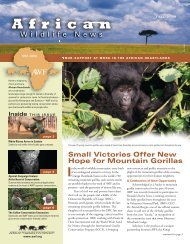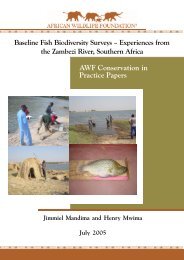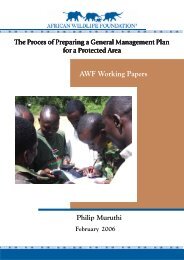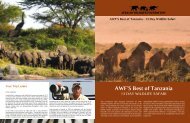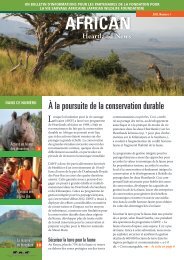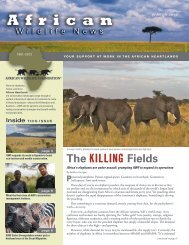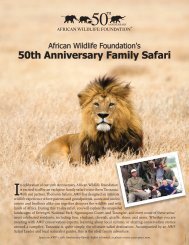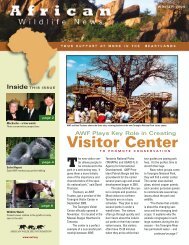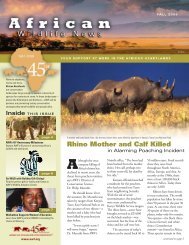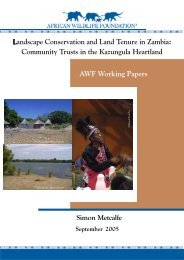Bernard Kissui: Protecting Lions in the Maasai ... - African Wildlife
Bernard Kissui: Protecting Lions in the Maasai ... - African Wildlife
Bernard Kissui: Protecting Lions in the Maasai ... - African Wildlife
- No tags were found...
Create successful ePaper yourself
Turn your PDF publications into a flip-book with our unique Google optimized e-Paper software.
WINTER 20091961-2009Billy DodsonHome to elephants,rh<strong>in</strong>os and more,<strong>African</strong> Heartlandsare conservationlandscapes large enough to susta<strong>in</strong> a diversity ofspecies for centuries to come. In <strong>the</strong>se landscapes—places like Kilimanjaro and Samburu—AWF and itspartners are pioneer<strong>in</strong>g last<strong>in</strong>g conservation strategiesthat benefit wildlife and people alike.Inside THIS ISSUEpage 1<strong>Bernard</strong> <strong>Kissui</strong><strong>Protect<strong>in</strong>g</strong> lions <strong>in</strong> <strong>the</strong> <strong>Maasai</strong> Steppe Heartland.Lion populations <strong>in</strong> Africa have plummeted over <strong>the</strong> past few decades. Us<strong>in</strong>g an applied science approach to conservation,AWF is hop<strong>in</strong>g to reverse this alarm<strong>in</strong>g trend <strong>in</strong> nor<strong>the</strong>rn Tanzania and <strong>in</strong> o<strong>the</strong>r places where lions still roam.<strong>Bernard</strong> <strong>Kissui</strong>/AWFwww.awf.orgpage 4Land Conservation<strong>African</strong> wildlife need vast open landscapes tolive, move and propagate. That’s why landconservation is at <strong>the</strong> heart of AWF’s wildlifeconservation strategy.page 7Conservation Enterprise <strong>in</strong> UgandaClouds Mounta<strong>in</strong> Gorilla Lodge <strong>in</strong> Uganda benefitsboth local people and mounta<strong>in</strong> gorilla conservation.<strong>Bernard</strong> <strong>Kissui</strong>: <strong>Protect<strong>in</strong>g</strong> <strong>Lions</strong><strong>in</strong> <strong>the</strong> <strong>Maasai</strong> Steppe HeartlandIt’s <strong>the</strong> dark of night. A small herd of cowsenclosed tightly <strong>in</strong> a thorn bush enclosurelists <strong>in</strong>to sleep. A pass<strong>in</strong>g pride of femalelions sense an easy meal. One powerful jump,and <strong>the</strong> lead lioness penetrates <strong>the</strong> boma, <strong>the</strong>o<strong>the</strong>r lionesses mov<strong>in</strong>g <strong>in</strong> to pull <strong>the</strong> livestockdown. Two animals are fatally <strong>in</strong>jured before<strong>the</strong> livestock owner can scare <strong>the</strong> lions off.There is no chance this scene can be <strong>in</strong>nor<strong>the</strong>rn Africa, because <strong>the</strong>re lions have longbeen ext<strong>in</strong>ct; but it can and does happen far<strong>the</strong>rsouth, <strong>in</strong> places like nor<strong>the</strong>rn Tanzania, where<strong>the</strong> loss of even a s<strong>in</strong>gle cow can devastate afamily’s economic well-be<strong>in</strong>g. The consequencesfor a pride of lions can be equally disastrous.“While livestock attacks tend to be isolated<strong>in</strong>cidents, <strong>the</strong> outcome is rarely good for livestock,humans or lions,” says Dr. <strong>Bernard</strong><strong>Kissui</strong>, head of AWF’s Lion ConservationProject <strong>in</strong> AWF’s <strong>Maasai</strong> Steppe Heartland.“Understandably, livestock owners who lose cattleare angry—and, retaliatory poison<strong>in</strong>gs andspear<strong>in</strong>gs claim <strong>the</strong> lives of several lions everyyear.” Such conflicts have led to <strong>the</strong> kill<strong>in</strong>g ofat least 133 lions <strong>in</strong> <strong>the</strong> area s<strong>in</strong>ce 2004. “Thistrend, if it cont<strong>in</strong>ues, could greatly threaten<strong>the</strong> survival of this precious species,” he says.Dr. <strong>Kissui</strong> heads up AWF’s Lion Researchand Conservation Project <strong>in</strong> <strong>the</strong> <strong>Maasai</strong> SteppeHeartland <strong>in</strong> nor<strong>the</strong>rn Tanzania, a vast ecosystemof open grass pla<strong>in</strong>s that is home to morethan 200 lions. Here two core protected areas—Tarangire and Manyara National Parks—offercont<strong>in</strong>ued on page 3
2 <strong>African</strong> <strong>Wildlife</strong> News www.awf.orgMachache ~ A FEW WORDSBOARD OF TRUSTEESDennis J. KellerchairSir Ketumile Masirevice chairRob<strong>in</strong> BerkeleytreasurerRazan K. Al MubarakEdward M. Armfield, Jr.Greg BehrmanMyma Belo-OsagieJacques J. BusquetPaul CampbellPayson ColemanDonald DixonLynn DolnickLisa FirestonePaul FletcherDonald C. GrahamWilliam E. (Wilber) JamesAdrian M. JayWilliam S. KalemaWalter H. Kanste<strong>in</strong>er IIIDorothy KimRobert E. K<strong>in</strong>gShana LaursenVictoria LeslieAnn K. LuskeyJames F. MakawaBenjam<strong>in</strong> W. MkapaKrist<strong>in</strong>a PerssonDr. Mamphela A. RampheleTia N. RoddyDavid ThomsonC. Bowdo<strong>in</strong> Tra<strong>in</strong>John R. WalterRichard W. Ween<strong>in</strong>gtrustees emeritiArthur W. ArundelE.U. Curtis BohlenJoan DonnerLeila S. GreenJohn H. Hem<strong>in</strong>wayGeorge C. HixonHenry P. McIntosh IVSally P<strong>in</strong>greeStuart T. Saunders, Jr.Russell E. Tra<strong>in</strong><strong>African</strong> <strong>Wildlife</strong> Newsis published four times a year.Publications and Market<strong>in</strong>g ManagerElizabeth Miranda©2009 <strong>African</strong> <strong>Wildlife</strong> Foundation1400 16th Street, N.W., Suite 120Wash<strong>in</strong>gton, D.C. 20036202-939-3333202-939-3332 (fax)1-888-494-5354E-mail: awn@awf.orgWebsite: www.awf.orgCFC# 11219Pr<strong>in</strong>ted with soy-based <strong>in</strong>kRecycled PaperThadeus BiamunguAchiev<strong>in</strong>gTransformationalImpactChange is someth<strong>in</strong>g that’s on many people’sm<strong>in</strong>ds <strong>the</strong>se days. With a New Year andnew leadership <strong>in</strong> government come newresolutions to make a difference <strong>in</strong> <strong>the</strong>world—to leave <strong>the</strong> world a better placethan we found it.At AWF, we’ve been work<strong>in</strong>g for changes<strong>in</strong>ce 1961. We’ve been chang<strong>in</strong>g <strong>the</strong> waypeople <strong>in</strong> Africa and around <strong>the</strong> world lookat conservation, open<strong>in</strong>g up new opportunitiesfor humans and wildlife to live toge<strong>the</strong>rso that <strong>the</strong>y both can thrive.We know that changes <strong>in</strong> wildlife managementmust be impactful. They must besusta<strong>in</strong>able. They must be strategic. In short,<strong>the</strong>y must be transformational.At AWF, we believe that <strong>the</strong> key totransformational impact is a landscapelevelapproach built on four pillars: landconservation, species protection, capacitybuild<strong>in</strong>g, and conservation enterprise. AtAWF, we approach conservation through awide-angle lens, consider<strong>in</strong>g <strong>the</strong> environmental,social, economic, and politicalimplications of our efforts.In this issue, you’ll read about some of<strong>the</strong> major projects that are contribut<strong>in</strong>g totransformational change <strong>in</strong> <strong>African</strong> wildlifeconservation. Three Sudanese graduatestudents jo<strong>in</strong> <strong>the</strong> ranks of more than 40Charlotte Fellows through an AWF fellowshipprogram that supports <strong>the</strong> education ofpromis<strong>in</strong>g <strong>African</strong> environmental managers.Our <strong>in</strong>vestment <strong>in</strong> sponsorship of advancededucation for <strong>African</strong> resource managementprofessionals is an <strong>in</strong>vestment that assuresthat conservation <strong>in</strong>novations will cont<strong>in</strong>uefor years to come.We are also br<strong>in</strong>g<strong>in</strong>g <strong>in</strong>novations <strong>in</strong>land conservation to fruition <strong>in</strong> several ofour Heartlands. Most recently, we havesecured and are rehabilitat<strong>in</strong>g overgrazedand neglected ranchlands for conservationand are develop<strong>in</strong>g land use plans that willbr<strong>in</strong>g tourism and economic opportunity towildlife-rich areas.As we look to <strong>the</strong> future, we see specificAWF conservation efforts add<strong>in</strong>g up to acomplete picture that <strong>in</strong>cludes thriv<strong>in</strong>gwildlife, prosperous local communities, and<strong>in</strong>dividuals empowered to make change <strong>in</strong><strong>the</strong> world. Enjoy read<strong>in</strong>g about <strong>the</strong> transformationalchange we’re creat<strong>in</strong>g <strong>in</strong> Africa andremember that your support is <strong>the</strong> key toour success.Patrick J. Berg<strong>in</strong>, Ph.D.Chief Executive OfficerHelen W. GichohiPresidentA lot has changed s<strong>in</strong>ce AWF undertook itsfirst project to support Mweka <strong>Wildlife</strong>College <strong>in</strong> Tanzania. But even as we seek tohave transformative impact we rema<strong>in</strong> true toour found<strong>in</strong>g mission—to build <strong>the</strong> capacityof <strong>African</strong>s to conserve, manage and derivebenefit from <strong>the</strong> wildlife and <strong>the</strong> wild landswhich make <strong>the</strong> cont<strong>in</strong>ent so unique.
www.awf.org <strong>African</strong> <strong>Wildlife</strong> News 3<strong>Bernard</strong> <strong>Kissui</strong> (Cont<strong>in</strong>ued from page 1)wildlife critical habitat but are toosmall to support lions year-round.It is outside <strong>the</strong> park, <strong>in</strong> <strong>the</strong>surround<strong>in</strong>g criss-cross of farms andsettled areas, that <strong>Bernard</strong>’s workcomes <strong>in</strong>to play.AWFNews <strong>in</strong> Brief“While <strong>the</strong> social behaviorand predatory habits of lions havefasc<strong>in</strong>ated researchers for decades,<strong>the</strong> <strong>in</strong>teraction between humanand lion populations is less wellunderstood,” says <strong>Bernard</strong>.<strong>Bernard</strong> has made understand<strong>in</strong>g<strong>the</strong> complex <strong>in</strong>terplay betweenlandscape, climate, populationand culture <strong>the</strong> cornerstone of hismission to safeguard <strong>the</strong> lions of<strong>the</strong> <strong>Maasai</strong> Steppe. By fitt<strong>in</strong>g lionswith radio collars and work<strong>in</strong>g withcommunities across <strong>the</strong> region, heis piec<strong>in</strong>g toge<strong>the</strong>r a detailed pictureof lion population density, habitatusage, demographic trends, andsocial-ecological dynamics <strong>in</strong> orderto create a long-term lion conservationstrategy.Out of his f<strong>in</strong>d<strong>in</strong>gs hasemerged an important key to ris<strong>in</strong>glion mortality rates: Dur<strong>in</strong>g <strong>the</strong> dryseason, <strong>the</strong> great cats center <strong>the</strong>iractivities with<strong>in</strong> <strong>the</strong> protected areas,where wildlife is plentiful. But once<strong>the</strong> ra<strong>in</strong>y season hits, <strong>the</strong> lions followungulates as <strong>the</strong>y migrate far beyond<strong>the</strong> park borders—often to <strong>the</strong> neares<strong>the</strong>rd of livestock.<strong>Bernard</strong> has come up with a simplebut groundbreak<strong>in</strong>g solution to head offlion-livestock predation. For <strong>the</strong> past twoyears, he has worked with local villagersto protect <strong>the</strong>ir herds by re<strong>in</strong>forc<strong>in</strong>g <strong>the</strong>irbomas with special fenc<strong>in</strong>g. This practicalmeasure is mak<strong>in</strong>g a big difference—m<strong>in</strong>imiz<strong>in</strong>g both lion deaths and <strong>the</strong>livestock losses that spur retaliatoryattacks. <strong>Bernard</strong> is also promot<strong>in</strong>g o<strong>the</strong>rimprovements <strong>in</strong> livestock security—such as improv<strong>in</strong>g herd<strong>in</strong>g practices andexperiment<strong>in</strong>g with stronger fencedesigns—to help pastoralists save <strong>the</strong>irlivestock as well as to protect lions.What’s more, he is educat<strong>in</strong>g communitiesabout <strong>the</strong> habits of lions and help<strong>in</strong>gto develop warn<strong>in</strong>g systems that alertpeople when lions are near.Mov<strong>in</strong>g as easily <strong>in</strong> traditional communities as <strong>in</strong> <strong>the</strong> academicworld, <strong>Bernard</strong> is a top steward of AWF’s applied conservationscience model.“Improved fenc<strong>in</strong>g is just one of<strong>the</strong> host of practical strategies spr<strong>in</strong>g<strong>in</strong>gfrom this conservation project,” says<strong>Bernard</strong>. “AWF is collaborat<strong>in</strong>g withcommunities, government authoritiesand o<strong>the</strong>r conservation stakeholders toensure that <strong>the</strong>se magnificent cats surviveand are ultimately an economic asset, nota hazard, to people.”Mov<strong>in</strong>g as easily <strong>in</strong> traditionalcommunities as <strong>in</strong> <strong>the</strong> academic world,<strong>Bernard</strong> is a top steward of AWF’sapplied conservation science model. Aformer AWF Charlotte Fellow (see p. 6),he recently earned his doctorate from<strong>the</strong> University of M<strong>in</strong>nesota and isrecognized today as one of Tanzania’stop conservation authorities. ■To support <strong>Bernard</strong> <strong>Kissui</strong>’s LionConservation Project <strong>in</strong> <strong>the</strong> <strong>Maasai</strong> SteppeHeartland visit www.awf.org/kissui.AWF Launches Digital Offer<strong>in</strong>gAWF announces a great new benefit ofmembership available to all e-subscribers:Africa Geographic Digital Magaz<strong>in</strong>e, astand-alone application packed with livevideo footage, superb photography andhigh-quality, <strong>in</strong>-depth coverage ofwildlife and conservation across Africa.Produced <strong>in</strong> partnership with AfricaGeographic, an Africa-based publisher ofmany award-w<strong>in</strong>n<strong>in</strong>g nature magaz<strong>in</strong>es,this excit<strong>in</strong>g new product is available freeto all AWF e-subscribers six times a year.If you already subscribe to our onl<strong>in</strong>enewsletter and updates, you will automaticallyget <strong>in</strong>formation about how toaccess Africa Geographic DigitalMagaz<strong>in</strong>e. Or visit http://www.awf.org/esubscribe and become an e-subscribertoday. ■The Campaign toSave Africa’sHeartlandsThanks to dedicatedmembers like you,we’ve made tremendousheadway <strong>in</strong> meet<strong>in</strong>g our$100 million Campaigngoal. As we go to pr<strong>in</strong>t,more than $82 milliondollars has been raised.Your <strong>in</strong>vestments areyield<strong>in</strong>g tremendousdividends <strong>in</strong> each andevery area of excellence<strong>in</strong> AWF’s conservationprograms. But toreach our goal ofrais<strong>in</strong>g $100million by June2009, we urgentlyneed your help. ■
Craig R. Sholley4 <strong>African</strong> <strong>Wildlife</strong> News www.awf.orgLand Conservation:A Firm Foundation for <strong>Wildlife</strong>AWF is direct<strong>in</strong>g conservation <strong>in</strong>itiatives on WestKilimanjaro ranch. Located between three national parks,this 70,000-acre area is used frequently by a unique andvulnerable population of elephants.<strong>African</strong> wildlife need vast open landscapes to live, move and propagate. Isolated islands of protectedland aren’t enough to ensure that wildlife survive and thrive. That’s why land conservation is at <strong>the</strong>heart of AWF’s wildlife conservation strategy, and one of <strong>the</strong> four pillars on which <strong>the</strong> <strong>African</strong>Heartlands program rests.In this issue, we <strong>in</strong>vite you to learn more about AWF’s land and habitat conservation programs. We areproud of what we are accomplish<strong>in</strong>g and hope <strong>the</strong> steady progress you see here re<strong>in</strong>forces your commitmentto <strong>the</strong> goals we share—and encourages you to support <strong>the</strong> Campaign to Save Africa’s Heartlands.Conservation at <strong>the</strong> Landscape LevelAWF’s land conservation efforts reach beyond human-drawnborders to establish vast areas of land where wildlife can roam freely.While consider<strong>in</strong>g all land use issues, <strong>in</strong>clud<strong>in</strong>g <strong>the</strong> needs of people,AWF works to secure wildlife movement corridors, habitat l<strong>in</strong>kages,dry season refuges, and dispersal areas by:◆ work<strong>in</strong>g with landowners to determ<strong>in</strong>e which lands shouldbe reserved for wildlife and which should be used for farms,graz<strong>in</strong>g and tourist lodg<strong>in</strong>g;◆ sign<strong>in</strong>g agreements with landowners to ensure susta<strong>in</strong>ablemanagement of areas of land;◆ help<strong>in</strong>g landowners form land trusts to secure land forlong-term conservation;◆ work<strong>in</strong>g with national park and protected area authoritiesto support plann<strong>in</strong>g, management, law enforcement andtransboundary collaboration around major parks.Over <strong>the</strong> course of our Campaign, AWF has brought several<strong>in</strong>novations <strong>in</strong> land conservation to fruition <strong>in</strong> <strong>the</strong> <strong>African</strong>Heartlands, <strong>in</strong>clud<strong>in</strong>g:• secur<strong>in</strong>g ADC Mutara Ranch, strategically located <strong>in</strong> <strong>the</strong>Samburu Heartland;• restor<strong>in</strong>g lands <strong>in</strong> <strong>the</strong> <strong>Maasai</strong> Steppe Heartland to benefitwildlife and local communities; and• develop<strong>in</strong>g land use plans that will br<strong>in</strong>g tourism andeconomic opportunity to <strong>the</strong> Kilimanjaro Heartland,while protect<strong>in</strong>g a unique population of elephants.Land Rega<strong>in</strong>edIn a unique partnership, AWF has worked for <strong>the</strong> last two yearswith <strong>the</strong> Kenyan Agricultural Development Corporation (ADC)and <strong>the</strong> Ol Pejeta Conservancy to br<strong>in</strong>g wildlife conservation and,ultimately, tourism and economic benefits to a critically-locatedgovernment-owned cattle ranch <strong>in</strong> Kenya.Ron Geatz
www.awf.org <strong>African</strong> <strong>Wildlife</strong> News 5Ron GeatzCraig R. SholleyADC Mutara Ranch occupies more than 60,000 acres <strong>in</strong> <strong>the</strong>midst of key wildlife movement corridors <strong>in</strong> Kenya’s semi-aridLaikipia region. It hosts a wide diversity of game, <strong>in</strong>clud<strong>in</strong>g severalof <strong>the</strong> big five, and rare species such as Grevy’s zebra, cheetah andPatas monkey. Partner<strong>in</strong>g with AWF, ADC set aside 12,000 acres forwildlife conservation and ecotourism and is manag<strong>in</strong>g <strong>the</strong> entire ranch<strong>in</strong> a manner that protects wildlife habitat and prevents poach<strong>in</strong>g. TheOl Pejeta Conservancy, a privately-owned wildlife area that bordersMutara, is provid<strong>in</strong>g <strong>the</strong> equipment and personnel as well as adviceon establishment of an ecotourism venture. Aerial surveys conductedrecently show <strong>in</strong>creas<strong>in</strong>g numbers of elephants, zebras, impala, giraffe,and o<strong>the</strong>r wildlife are once aga<strong>in</strong> us<strong>in</strong>g <strong>the</strong> ranchlands.“This type of partnership between a government agency, a privatecompany and a conservation organization is one of <strong>the</strong> <strong>in</strong>novativeways AWF is work<strong>in</strong>g to secure <strong>the</strong> future of wildlife conservation <strong>in</strong>Africa,” says Dr. Helen Gichohi, President of AWF.Ranch RehabilitationAno<strong>the</strong>r transformational project is Manyara Ranch. The 44,000-acre ranch occupies a critical location <strong>in</strong> a wildlife corridor that liesbetween Tarangire and Lake Manyara National Parks <strong>in</strong> Tanzania.When <strong>the</strong> ranch was designated for sale as part of a governmentprivatization drive, AWF facilitated <strong>the</strong> formation of <strong>the</strong> TanzaniaLand Conservation Trust (TLCT) to hold Manyara Ranch forconservation, improved livestock production, and tourism.Over <strong>the</strong> past two years, AWF has raised and <strong>in</strong>vested morethan $2 million <strong>in</strong> <strong>the</strong> rehabilitation of <strong>the</strong> ranch. Dur<strong>in</strong>g this period,<strong>the</strong> vegetation and security of <strong>the</strong> ranch have greatly improved andwildlife numbers are <strong>in</strong>creas<strong>in</strong>g. Ranch management has rebuiltimportant dams and <strong>the</strong> livestock herd is <strong>in</strong>creas<strong>in</strong>g <strong>in</strong> value. TheTLCT has rebuilt <strong>the</strong> Manyara Ranch primary school at a new site.A new <strong>in</strong>vestment <strong>in</strong> tourism that will create jobs, local revenueshar<strong>in</strong>g, and taxes is <strong>in</strong> <strong>the</strong> works.Land acquisition and protection is a focus of AWF’s work <strong>in</strong> nor<strong>the</strong>rn Kenya, that secures safehavens for <strong>the</strong> reticulated giraffe and scores of o<strong>the</strong>r species.Elephant StepsBuild<strong>in</strong>g on our experiences with <strong>the</strong> Manyara Ranch project,AWF is hard at work <strong>in</strong>stitut<strong>in</strong>g conservation <strong>in</strong>itiatives on WestKilimanjaro Ranch.The West Kilimanjaro Ranch, roughly 70,000 acres, sits on <strong>the</strong>west side of Mt. Kilimanjaro at <strong>the</strong> center of a triangle formed bythree national parks—Mt. Kilimanjaro, Arusha, and Amboseli.This area is strategic as it is home to a sizeable population ofelephants, identified by AWF researcher Alfred Kikoti who collectedand analyzed several years worth of satellite data.Through a long-term arrangement with <strong>the</strong> Tanzaniangovernment, AWF is work<strong>in</strong>g to rehabilitate and manage <strong>the</strong>ranch, revers<strong>in</strong>g years of overgraz<strong>in</strong>g and disrepair, and provid<strong>in</strong>g ahealthy ecosystem for <strong>the</strong> area’s elephants.Support <strong>the</strong> F<strong>in</strong>al Leg of <strong>the</strong> Heartlands CampaignOver <strong>the</strong> course of our Campaign, AWF has had manyfirsts—our largest public and private gifts ever, our best fiscal yearon record, and completion of several highly creative conservationenterprise projects. AWF’s planners,researchers, policy anddevelopment experts—on-<strong>the</strong>ground,native <strong>African</strong>s—arecont<strong>in</strong>ually pursu<strong>in</strong>g newopportunities to expand landconservation <strong>in</strong> creative newways. Your support for <strong>the</strong>Campaign to Save <strong>the</strong> Africa’sHeartlands is <strong>the</strong> key to secur<strong>in</strong>g<strong>the</strong> future of Africa’s lands,people and wildlife. ■Kathleen FitzgeraldADC Mutara Ranch is located <strong>in</strong> Kenya’s Laikipia region, a vast plateau world-renowned for itsbreathtak<strong>in</strong>g landscapes and where many species, such as <strong>the</strong>se eland, roam.To make your pledge todayvisit www.awf.org/campaignor phone AWF’s DevelopmentDepartment toll-free at1-888-494-5354.
6 <strong>African</strong> <strong>Wildlife</strong> News www.awf.orgMeet <strong>the</strong> New Charlotte FellowsThis year’s Charlotte Fellows all make <strong>the</strong>ir home <strong>in</strong> sou<strong>the</strong>rn Sudan, a land still rich <strong>in</strong> wildlifedespite years of civil war. Each will use <strong>the</strong> fellowship to pursue a master’s <strong>in</strong> wildlife managementat Moi University’s School of Natural Resources Management <strong>in</strong> Kenya.AWF <strong>in</strong>troduced <strong>the</strong> Charlotte Conservation Fellows program <strong>in</strong> 1996 to provide support for<strong>African</strong> nationals pursu<strong>in</strong>g masters’ degrees or doctoral research <strong>in</strong> conservation-related fields. Theprogram was launched <strong>in</strong> tribute to <strong>the</strong> late Charlotte Kidder Ramsay, a long-time conservationist. Eachyear, AWF supports as many as five Charlotte Fellows. While expenses and materials vary accord<strong>in</strong>g to<strong>the</strong> recipient, scholarships are awarded for amounts of up to $25,000. S<strong>in</strong>ce its <strong>in</strong>ception, <strong>the</strong> programhas helped more than 40 students from East, West, Central and sou<strong>the</strong>rn Africa.Get to know Sudan’s future conservation leaders….Baya Philip Brown NgereArea of Research: Elephant populations <strong>in</strong> sou<strong>the</strong>rn SudanAreas of Interest: <strong>Wildlife</strong> population ecologyProfessional Goals: Foster conservation <strong>in</strong> Sudan by work<strong>in</strong>g with governmentand NGOs“Sou<strong>the</strong>rn Sudan is blessed with a great variety of wildlife, but we lack <strong>the</strong> capacityand skills for proper conservation management, and our wildlife have suffered.”Lona Nalurit Darius GoreArea of Research: Human-wildlife conflict <strong>in</strong> Bad<strong>in</strong>gilo National Park, SudanAreas of Interest: Conservation education and conservation biologyProfessional Goals: Build better conservation management through improvedconservation education <strong>in</strong> sou<strong>the</strong>rn Sudan“The good news is that, with sufficient fund<strong>in</strong>g, skilled personnel, and propermanagement practices, wildlife <strong>in</strong> sou<strong>the</strong>rn Sudan can rebound quickly from<strong>the</strong> challenges of <strong>the</strong> past 20 years.”Paul Lado Demetry JubekArea of Research: Identify<strong>in</strong>g and mitigat<strong>in</strong>g threats to <strong>the</strong> Nile lechwe (antelope)Areas of Interest: Conservation biology and environmental impact assessmentProfessional Goals: Advance wildlife research <strong>in</strong> sou<strong>the</strong>rn Sudan“Numerous development projects are be<strong>in</strong>g done <strong>in</strong> sou<strong>the</strong>rn Sudan without EnvironmentalImpact Assessments, putt<strong>in</strong>g pressure on biological diversity. If we don’t do someth<strong>in</strong>gnow, we will never see some of <strong>the</strong> species <strong>the</strong>re aga<strong>in</strong>.”Endangered Liaisons: A Tribute to Africa and Its <strong>Wildlife</strong>In 1987, Don Shay traveled to Kenya on a two-week photographic safari. Stricken withwhat he calls “safari fever,” Shay has s<strong>in</strong>ce returned to Africa 14 times, tour<strong>in</strong>g dozens of wildlifepreserves <strong>in</strong> n<strong>in</strong>e different countries and photograph<strong>in</strong>g thousands of animals and landscapes.Shay’s just-released Endangered Liaisons, a stunn<strong>in</strong>gly beautiful memoir, captures Shay’s travels<strong>in</strong> Africa. The coffee-table book features seven chapters, each of which focuses on a particulardest<strong>in</strong>ation and, <strong>in</strong> most cases, a particular species of animal. The photographs are <strong>in</strong>terwovenwith <strong>in</strong>sightful and humorous accounts of life on safari along with well-researched <strong>in</strong>formation.A long-time, loyal supporter of AWF, Shay has pledged to donate $25 of every copy ofEndangered Liaisons purchased by our members to AWF. Accompany Shay as he traces <strong>the</strong> GreatMigration through <strong>the</strong> Serengeti or share <strong>the</strong> suspense as a lioness stalks prey <strong>in</strong> <strong>the</strong> <strong>Maasai</strong> Mara<strong>in</strong> Kenya. Visit www.africagraphica.com/awf to purchase Shay’s book today and you will alsoreceive an Endangered Liaisons 2009 wall calendar. ■Author Don Shay will donate a portion of <strong>the</strong>sales from his stunn<strong>in</strong>g new book to AWF.To buy your copy ofEndangered Liaisons, visitwww.africagraphica.com/awf.
www.awf.org <strong>African</strong> <strong>Wildlife</strong> News 7ConservationEnterprise Goesto UgandaDraw<strong>in</strong>g on 30 years of experience <strong>in</strong> mounta<strong>in</strong> gorilla conservation,AWF recently extended its conservation enterprise model <strong>in</strong>toUganda, open<strong>in</strong>g Clouds Mounta<strong>in</strong> Gorilla Lodge on <strong>the</strong> edge ofBw<strong>in</strong>di Impenetrable National Park.The result of a partnership between <strong>the</strong> Nkur<strong>in</strong>go community, AWFthrough <strong>the</strong> International Gorilla Conservation Program (IGCP), and a lead<strong>in</strong>gprivate operator, <strong>the</strong> lodge benefits both <strong>the</strong> local people and mounta<strong>in</strong> gorillaconservation. Guests stay<strong>in</strong>g at <strong>the</strong> lodge have <strong>the</strong> opportunity to viewUganda’s Nkur<strong>in</strong>go group of mounta<strong>in</strong> gorillas, which live on <strong>the</strong> sou<strong>the</strong>asternedge of Bw<strong>in</strong>di Impenetrable Park.The local Nkur<strong>in</strong>go community has a significant ownership stake <strong>in</strong> <strong>the</strong>lodge through <strong>the</strong> Nkur<strong>in</strong>go Community Development Foundation (NCDF),which represents 30,000 people <strong>in</strong> 23 local villages. With strategic supportfrom IGCP, NCDF planned and secured f<strong>in</strong>anc<strong>in</strong>g for <strong>the</strong> lodge, which wasbuilt with fund<strong>in</strong>g from <strong>the</strong> U.S. Agency for International Development. Aportion of each night’s stay goes to projects such as water tanks, schools, roads,tree plant<strong>in</strong>g and o<strong>the</strong>r conservation and community development projects.Besides benefit<strong>in</strong>g <strong>the</strong> local communities, <strong>the</strong> lodge is designed to exposetourists to local people and culture.Clouds offers visitors unique and comfortable accommodations. It has tencomfortable stone cottages and luxurious yet warm surround<strong>in</strong>gs. Perched highon a ridge <strong>in</strong> Bw<strong>in</strong>di, <strong>the</strong> ma<strong>in</strong> balcony of <strong>the</strong> lodge looks out <strong>in</strong>to <strong>the</strong> lushmounta<strong>in</strong> ra<strong>in</strong>forest of <strong>the</strong> Virunga Volcanoes.Made possible with your support, Clouds is <strong>the</strong> second AWF-supportedlodge designed to conserve mounta<strong>in</strong> gorillas <strong>in</strong> a way that benefits people.Saby<strong>in</strong>yo Silverback Lodge opened <strong>in</strong> Rwanda last year. ■Visitors to Clouds will enjoy comfortable accommodationsand hospitable service after a long day hik<strong>in</strong>g <strong>the</strong> steeptrails of Bw<strong>in</strong>di.Michael RourkeClouds gives people economic<strong>in</strong>centive to conserve <strong>the</strong> highlyendangered mounta<strong>in</strong> gorilla.Craig R. SholleyIBM Rolls Up ItsSleeves on Behalfof <strong>Wildlife</strong>P<strong>in</strong>-striped suits may abound <strong>in</strong> <strong>the</strong> executivecorridors of IBM, but <strong>in</strong> <strong>the</strong> <strong>Maasai</strong>Steppe Heartland <strong>the</strong> only stripes <strong>in</strong> sightare on <strong>the</strong> herds of zebras that roam <strong>the</strong> opensavanna. It is <strong>the</strong>se k<strong>in</strong>ds of stripes that sevenIBM volunteers have traveled to Tanzania topromote and protect.The volunteers are part of IBM’s newCorporate Services Corps program, rolled outlast year. A private sector version of <strong>the</strong> PeaceCorps, <strong>the</strong> program was created to improveemployees’ leadership skills, <strong>in</strong>crease <strong>the</strong> company’sglobal presence, and support communities <strong>in</strong>less-developed countries. Of <strong>the</strong> astound<strong>in</strong>g5,000 IBM professionals who applied for <strong>the</strong>program, 100 people were selected. IBM senttwo teams to work <strong>in</strong> Tanzania, with severalmembers of each team assigned to work withAWF.The program is about giv<strong>in</strong>g back—for both<strong>the</strong> volunteers and <strong>the</strong> nonprofits that work with<strong>the</strong>m. “What IBM as a company gets is leaderswith a range of skills that function <strong>in</strong> <strong>the</strong> globalworld. What <strong>the</strong> <strong>in</strong>dividuals get is a unique set ofleadership opportunities and tra<strong>in</strong><strong>in</strong>g experiences.And what communities get would be <strong>the</strong>best IBM has to offer,” says Stanley Litow, Vice-President of Corporate Citizenship andCorporate Affairs at IBM.And <strong>the</strong> best is what AWF and <strong>the</strong> communitieswe work with are surely gett<strong>in</strong>g. “Thesehighly capable <strong>in</strong>dividuals and top bus<strong>in</strong>ess consultantsbr<strong>in</strong>g a new level of expertise to ourwork,” says Steven Kiruswa, Director of <strong>the</strong><strong>Maasai</strong> Steppe Heartland, where <strong>the</strong> volunteersare based. “With IBM’s help, we have identifiedand created bus<strong>in</strong>ess plans for two conservationenterprises that will support wildlife and landprotection and benefit <strong>the</strong> people liv<strong>in</strong>g <strong>in</strong> <strong>the</strong>resource-rich Burunge and <strong>the</strong> Eduimet regions.”The volunteers, <strong>in</strong> turn, are gett<strong>in</strong>g satisfactionand real results. “I wasn’t sure what to expectand how much AWF would really be able to use<strong>the</strong> Bus<strong>in</strong>ess Plan I created…but I found outyesterday that <strong>the</strong> next step is to submit it toUSAID to try to get fund<strong>in</strong>g for <strong>the</strong> project!What could be better than that?” says AmberK<strong>in</strong>g, a software eng<strong>in</strong>eer.Indeed, what could be better? ■
8 <strong>African</strong> <strong>Wildlife</strong> News www.awf.org<strong>Wildlife</strong> WatchHartebeestCraig R. SholleyPaul ThomsonThe <strong>African</strong> hartebeest (Alcelaphusbuselaphus) is a large, fawn-coloredantelope found on <strong>the</strong> grasslands ofEast, West and sou<strong>the</strong>rn Africa. At firstglance, this antelope looks a bit strangelyput-toge<strong>the</strong>r and less elegant than o<strong>the</strong>rantelopes. But, this highly evolved ungulateis far from clumsy and, <strong>in</strong> fact, is <strong>the</strong> fastestof all antelopes.But its speed and endurance aside, <strong>the</strong>hartebeest leads a fairly <strong>in</strong>active lifestylewhich keeps it from mix<strong>in</strong>g widely witho<strong>the</strong>r hartebeest populations, result<strong>in</strong>g <strong>in</strong>several subspecies of hartebeest. Coke’shartebeest, also known as “kongoni,” is <strong>the</strong>most widespread of <strong>the</strong> subspecies.Young are born throughout <strong>the</strong> year,but conception and breed<strong>in</strong>g peaks are likelyThe <strong>African</strong>Hartebeestis <strong>the</strong>fastestof allantelopes.dependent on <strong>the</strong> availability of food. Unlikewildebeest, a hartebeest female isolatesherself <strong>in</strong> scrub to give birth and leaves <strong>the</strong>young calf hidden for two weeks, onlyvisit<strong>in</strong>g it briefly to suckle. Offspr<strong>in</strong>g staywith <strong>the</strong>ir mo<strong>the</strong>rs for quite a while. Maleoffspr<strong>in</strong>g stay for as long as three years andfemale offspr<strong>in</strong>g stay close to <strong>the</strong>ir mo<strong>the</strong>rsup until <strong>the</strong> time <strong>the</strong>y give birth to calves of<strong>the</strong>ir own.Although a prolific breeder and even adom<strong>in</strong>ant species <strong>in</strong> some areas, <strong>the</strong> hartebeesthas probably suffered <strong>the</strong> greatestreduction <strong>in</strong> range of all <strong>African</strong> rum<strong>in</strong>ants.This is both because it is easily hunted due toits idle nature and because its diet is almostequal to that of cattle—it must compete forfood resources. ■A GoldenOpportunityAmidst <strong>the</strong> f<strong>in</strong>ancialturmoil rock<strong>in</strong>g globalmarkets, <strong>the</strong>re is somegood news. Congress recentlypassed <strong>the</strong> Emergency EconomicStabilization Act of 2008. Thislaw enables people 70-½ or olderto make a gift to qualified nonprofitsfrom a traditional IRA—without <strong>the</strong> distribution be<strong>in</strong>g<strong>in</strong>cluded as taxable <strong>in</strong>come.Under this Act, <strong>in</strong>dividuals canask <strong>the</strong> adm<strong>in</strong>istrator of <strong>the</strong>irIRA fund to make a directdistribution to <strong>the</strong>ir favoritecharity of up to $100,000 dur<strong>in</strong>g2009. Fur<strong>the</strong>rmore, a directdistribution may count toward<strong>the</strong> annual traditional IRAmandatory withdrawal amount.If you are <strong>in</strong> a position to takeadvantage of this new law, wehope you’ll speak with yourf<strong>in</strong>ancial advisor and chooseAWF as your recipient ■DONATEI Want to Do Even More to Protect Africa’s <strong>Wildlife</strong>!YES, I can see that my membership donations are mak<strong>in</strong>g a difference—and I want to do even more to help Africa’s wildlife. Please use <strong>the</strong>enclosed tax-deductible donation where it is most urgently needed <strong>in</strong>AWF’s Campaign to Save Africa’s Heartlands:❑ $25 ❑ $50 ❑ $75 ❑ $100 ❑ $500 ❑ O<strong>the</strong>r $_______WITHCONFIDENCETODAY!Craig R. SholleyNAMEADDRESSCITY STATE ZIPPHONE■■Please send me my complimentaryDVD on AWF’s Campaign to SaveAfrica’s Heartlands so I can learnmore about this vital campaign.Please send me your onl<strong>in</strong>e newsletter,AWF Africa News Onl<strong>in</strong>e, with <strong>the</strong> lateston Africa’s wildlife and wild lands.E-MAIL ADDRESS■Please send me <strong>in</strong>formation about...___<strong>in</strong>clud<strong>in</strong>g AWF <strong>in</strong> my will.___gifts that pay me <strong>in</strong>come for life.___I have already <strong>in</strong>cluded AWF<strong>in</strong> my estate plans.Thank you! Please detach this form and return it with your taxdeductiblegift <strong>in</strong> <strong>the</strong> enclosed envelope to: <strong>African</strong> <strong>Wildlife</strong>Foundation, 1400 Sixteenth Street, N.W., Suite 120,Wash<strong>in</strong>gton, D.C. 20036.If you have questions, call us at 1-888-494-5354. Or, e-mail us at<strong>African</strong>wildlife@awf.org.www.awf.orgA093


